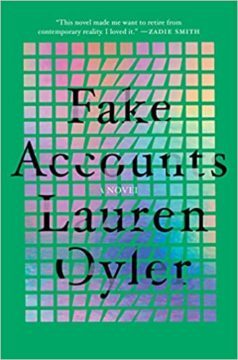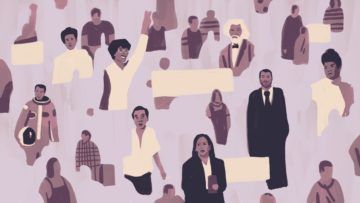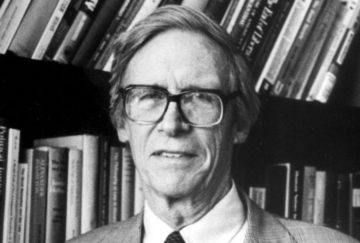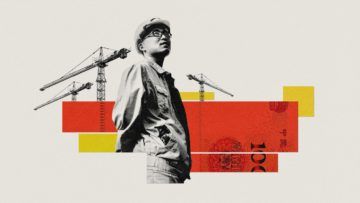https://www.youtube.com/watch?v=YWODh7of6GU&ab_channel=NoOneElseUploadedIt
https://www.youtube.com/watch?v=YWODh7of6GU&ab_channel=NoOneElseUploadedIt
Jennifer Wilson at The Nation:
 In Ferrante’s most recent novel, The Lying Life of Adults, we are pulled yet again into the story with the tale of a missing woman, Aunt Vittoria. Unlike Lila, she has not disappeared altogether but is estranged from her brother, Andrea, and her 12-year-old niece, Giovanna, who narrates the story. While Giovanna and her parents live in a middle-class section of Naples, Vittoria has remained in Pascone, the working-class neighborhood in the city’s Industrial Zone where she and Andrea were raised. Throughout the novel, we get conflicting stories from Vittoria and Andrea about what led to their estrangement. A dispute about who should inherit their mother’s apartment following her death was certainly the breaking point, but there had long been tension between them. Early on, it becomes clear that Andrea is frustrated that his sister did not respond to the poverty of their childhood in the same way he did: by leaving Pascone behind with no qualms or doubts and embracing the tastes and habits of the Italian bourgeoisie. But what takes longer to be revealed is that Vittoria is perhaps no better, that her working-class pride may not be as sturdy as she wants her young, wide-eyed niece to think.
In Ferrante’s most recent novel, The Lying Life of Adults, we are pulled yet again into the story with the tale of a missing woman, Aunt Vittoria. Unlike Lila, she has not disappeared altogether but is estranged from her brother, Andrea, and her 12-year-old niece, Giovanna, who narrates the story. While Giovanna and her parents live in a middle-class section of Naples, Vittoria has remained in Pascone, the working-class neighborhood in the city’s Industrial Zone where she and Andrea were raised. Throughout the novel, we get conflicting stories from Vittoria and Andrea about what led to their estrangement. A dispute about who should inherit their mother’s apartment following her death was certainly the breaking point, but there had long been tension between them. Early on, it becomes clear that Andrea is frustrated that his sister did not respond to the poverty of their childhood in the same way he did: by leaving Pascone behind with no qualms or doubts and embracing the tastes and habits of the Italian bourgeoisie. But what takes longer to be revealed is that Vittoria is perhaps no better, that her working-class pride may not be as sturdy as she wants her young, wide-eyed niece to think.
more here.
Costica Bradatan at Commonweal:
 The interviewers often push Girard to explain how his theory applies to real life, and he is happy to oblige. The theory’s journey into the world is a great story in its own right. No sooner did his argument reach a certain “elegance” than Girard started to realize its growing applicability: “You suddenly see that there is a single explanation for a thousand different phenomena.” He first formulated his theory in a book of literary history, then went on to apply it to the study of mythology and religion, then to politics and international relations, then to society and economy, fashion and eating disorders, and whatnot. Just open a newspaper and pick something, anything, at random. Even the stock market? Especially the stock market, Girard would respond. That’s “the most mimetic institution” of all—indeed, a textbook illustration of how mimetic theory works: “You desire stock not because it is objectively desirable. You know nothing about it, but you desire stuff exclusively because other people desire it. And if other people desire it, its value goes up and up and up.” There is hardly a field, sphere of life, or situation, where Girard’s theory does not apply. He finds that fascinating. Some of his readers find it too good to be true. Others find it scandalous.
The interviewers often push Girard to explain how his theory applies to real life, and he is happy to oblige. The theory’s journey into the world is a great story in its own right. No sooner did his argument reach a certain “elegance” than Girard started to realize its growing applicability: “You suddenly see that there is a single explanation for a thousand different phenomena.” He first formulated his theory in a book of literary history, then went on to apply it to the study of mythology and religion, then to politics and international relations, then to society and economy, fashion and eating disorders, and whatnot. Just open a newspaper and pick something, anything, at random. Even the stock market? Especially the stock market, Girard would respond. That’s “the most mimetic institution” of all—indeed, a textbook illustration of how mimetic theory works: “You desire stock not because it is objectively desirable. You know nothing about it, but you desire stuff exclusively because other people desire it. And if other people desire it, its value goes up and up and up.” There is hardly a field, sphere of life, or situation, where Girard’s theory does not apply. He finds that fascinating. Some of his readers find it too good to be true. Others find it scandalous.
more here.
—for Luke
It was a green before a fiddler stood on it,
and made mirth, and never stopped playing.
It was grass. Or maybe a greenwood. Maybe
underbrush, thick at your knees. Unparsable.
We have each taken something that belonged
to itself first, something that was once a wide
and open green. What turns red in spring
before it greens? The redbud trees along
the highway. Also the human heart. Each
glows lamp-like on the road to church.
Virginia rolls with fields and when I say:
it was a field before it was a battlefield,
you say: “And after.” Yes, and after.
by Hannah Vanderhart
from The Ecotheo Review
Laura Cumming in The Guardian:
 Albrecht Dürer was the first great sightseer in the history of art, travelling Europe to see conjoined twins, Aztec gold, Venetian gondolas and the bones of an 18ft giant. He crossed the Alps more than once and voyaged for six days in the freezing winter of 1520 to see a whale on a beach in Zeeland. The ship was nearly wrecked, but somehow Dürer saved the day and they eventually reached the shore. The sands were empty. The great creature had sailed away.
Albrecht Dürer was the first great sightseer in the history of art, travelling Europe to see conjoined twins, Aztec gold, Venetian gondolas and the bones of an 18ft giant. He crossed the Alps more than once and voyaged for six days in the freezing winter of 1520 to see a whale on a beach in Zeeland. The ship was nearly wrecked, but somehow Dürer saved the day and they eventually reached the shore. The sands were empty. The great creature had sailed away.
This magnificent new book by Philip Hoare takes its title from that tale, but only as a point of departure. The narrative soon turns into a trip of another kind entirely, a captivating journey through art and life, nature and human nature, biography and personal memoir. Giants walk the earth: Dürer and Martin Luther, Shakespeare and Blake, Thomas Mann, Marianne Moore, WH Auden, David Bowie. Hoare summons them like Prospero, his writing the animating magic that brings the people of the past directly into our present and unleashes spectacular visions along the way.
Just to follow him to that same beach in Zeeland, for instance, is to be entranced by his descriptions of deserted ports, windblown flatlands and shadowy waters. Hoare sees the creatures Dürer never saw, as if on his behalf. He offers the poignant revelation that the giant’s bones were actually those of a bowhead whale, knowing what it would have meant to the artist. Shown the day’s catch in a local restaurant, he marvels at the orange spots on the glistening brown plaice – “the fingerprints of a saint” – and imagines Dürer immediately drawing the fish on his napkin. Both men are present in that moment; both of Hoare’s pictures are perfect.
More here.
Sabrina Imbler in The New York Times:
 If you were somehow able to travel back in time some 130,000 years and chance upon a Neanderthal, you might find yourself telling them about some of humanity’s greatest inventions, such as spanakopita and TikTok. The Neanderthal would have no idea what you were saying, much less talking about, but they might be able to hear you perfectly, picking up on the voiceless consonants “t,” “k” and “s” that appear in many modern human languages. A team of scientists has reconstructed the outer and middle ear of Neanderthals and concluded that they listened to the world much like we do. Their study, published Monday in Nature Ecology & Evolution, found that Neanderthals had the anatomical ability to perceive a similar range of sounds as modern Homo sapiens, including upper speech frequencies that mainly involve consonant production.
If you were somehow able to travel back in time some 130,000 years and chance upon a Neanderthal, you might find yourself telling them about some of humanity’s greatest inventions, such as spanakopita and TikTok. The Neanderthal would have no idea what you were saying, much less talking about, but they might be able to hear you perfectly, picking up on the voiceless consonants “t,” “k” and “s” that appear in many modern human languages. A team of scientists has reconstructed the outer and middle ear of Neanderthals and concluded that they listened to the world much like we do. Their study, published Monday in Nature Ecology & Evolution, found that Neanderthals had the anatomical ability to perceive a similar range of sounds as modern Homo sapiens, including upper speech frequencies that mainly involve consonant production.
The authors believe this research has implications beyond the ear. Any insight into how Neanderthals heard can offer new clues into one of the most-debated, unresolved questions about the ancient hominids: whether Neanderthals spoke. Hearing and speech are often coupled in the animal kingdom, according to Dan Dediu, a language scientist at the Lumière University Lyon 2 in France, who was not involved with the research. “It would be meaningless for an animal to produce a frequency that can’t be heard by conspecifics,” he said.
More here.
Andy Kroll in Rolling Stone:

Sander van der Linden was working in his office at the University of Cambridge a few years ago when he received a strange phone call. A professor of social psychology and director of the Cambridge Social Decision-Making Laboratory, van der Linden is one of the world’s leading researchers on how to combat the scourge of disinformation and misinformation. He receives requests all the time about his work from government agencies, media organizations, and civil-society groups. But the person who called that day was not a bureaucrat or a diplomat. It was a representative from L’Oréal, the multi-billion-dollar global beauty product company. L’Oréal had what it called a “scientific disinformation” problem related to some of its products. Could van der Linden help?
At the heart of van der Linden’s research is a theory: Our information crisis can and should be treated like a virus. Responding to fake stories or conspiracy theories after the fact is woefully insufficient, just as post-infection treatments don’t compare to vaccines. Indeed, a growing body of social science suggests that fact-checks and debunkings do little to correct falsehoods after people have seen a piece of misinformation (the unintentional spread of misleading or false stories) or disinformation (the intentional spread of such a story with a purpose in mind). Van der Linden believes we can protect people against bad information through something akin to inoculation. A truth vaccine. He calls this tactic “prebunking.”
More here.
Paul Rincon at the BBC:
 Scientists have come up with a computer program that can master a variety of 1980s exploration games, paving the way for more self-sufficient robots.
Scientists have come up with a computer program that can master a variety of 1980s exploration games, paving the way for more self-sufficient robots.
They created a family of algorithms (software-based instructions for solving a problem) able to complete classic Atari games, such as Pitfall.
Previously, these scrolling platform games have been challenging to solve using artificial intelligence (AI).
The algorithms could help robots better navigate real-world environments.
This remains a core challenge in the fields of robotics and artificial intelligence. The types of environments in question include disaster zones, where robots could be sent out to search for survivors, or even just the average home.
The work in this study falls into an area of AI research known as reinforcement learning.
More here.
Carl Zimmer in the New York Times:
 Last spring, coyotes strolled down the streets of San Francisco in broad daylight. Pods of rarely seen pink dolphins cavorted in the waters around Hong Kong. In Tel Aviv, jackals wandered a city park, a herd of mountain goats took over a town in Wales, and porcupines ambled through Rome’s ancient ruins. As the canals in Venice turned strangely clear, cormorants started diving for fish, and Canada geese escorted their goslings down the middle of Las Vegas Boulevard, passing empty shops displaying Montblanc pens and Fendi handbags.
Last spring, coyotes strolled down the streets of San Francisco in broad daylight. Pods of rarely seen pink dolphins cavorted in the waters around Hong Kong. In Tel Aviv, jackals wandered a city park, a herd of mountain goats took over a town in Wales, and porcupines ambled through Rome’s ancient ruins. As the canals in Venice turned strangely clear, cormorants started diving for fish, and Canada geese escorted their goslings down the middle of Las Vegas Boulevard, passing empty shops displaying Montblanc pens and Fendi handbags.
Nature was expanding as billions of people were retreating from the Covid-19 pandemic. The change was so swift, so striking that scientists needed a new name for it: the anthropause.
But the anthropause did more than reconfigure the animal kingdom. It also altered the planet’s chemistry. As factories grew quiet and traffic dropped, ozone levels fell by 7 percent across the Northern Hemisphere. As air pollution across India dropped by a third, mountain snowpacks in the Indus Basin grew brighter. With less haze in the atmosphere, the sky let more sunlight through.
More here.
Ryan Ruby in the New Left Review:
 Since its consolidation at the end of the eighteenth century, the realist novel has been the premier vehicle for the depiction of contemporary life. For over two hundred years, a relatively fixed set of representational techniques – point-of-view, voice, description, dialogue, plot – has managed to adapt to the radical transformations of modernity: the nuclearization of the family, the entry of women into public life, the liberalization of sexual mores, industrialization and deindustrialization, urbanization and suburbanization, secularization, the lifeworlds of dominated classes and colonized nations, war on a planetary scale, and new conceptions of cognition and identity formation, to name just a few. By doubling down on its core strength – the linguistic representation of inner experience – the novel even managed to fend off challenges from rival media, like film and television. But over the last decade or so it has become clear that changes in the texture of the contemporary itself, due primarily to the diffusion of digital networked media, have begun to strain the capacity of the novel – as an institution, as a medium, as a form – to fulfil its traditional remit.
Since its consolidation at the end of the eighteenth century, the realist novel has been the premier vehicle for the depiction of contemporary life. For over two hundred years, a relatively fixed set of representational techniques – point-of-view, voice, description, dialogue, plot – has managed to adapt to the radical transformations of modernity: the nuclearization of the family, the entry of women into public life, the liberalization of sexual mores, industrialization and deindustrialization, urbanization and suburbanization, secularization, the lifeworlds of dominated classes and colonized nations, war on a planetary scale, and new conceptions of cognition and identity formation, to name just a few. By doubling down on its core strength – the linguistic representation of inner experience – the novel even managed to fend off challenges from rival media, like film and television. But over the last decade or so it has become clear that changes in the texture of the contemporary itself, due primarily to the diffusion of digital networked media, have begun to strain the capacity of the novel – as an institution, as a medium, as a form – to fulfil its traditional remit.
The reason most often given for this is that, bound to the format and economics of the book, an increasingly Jurassic technology, the novel’s production cycle cannot keep pace with the accelerated timescale of the internet, which contracts what counts as the contemporary into shorter and shorter units of duration by flooding the collective consciousness with data.
More here.
There is a hole.
In the hole is everything
people will do
to each other.
The hole goes down and down.
It has many rooms
like graves and like graves
they are all connected.
Roots hang from the dirt
in craggy chandeliers.
It’s not clear
where the hole stops
beginning and where
it starts to end.
It’s warm and dark down there.
The passages multiply.
There are ballrooms.
There are dead ends.
The air smells of iron and
crushed flowers.
People will do anything.
They will cut the hands off children.
Children will do anything—
In the hole is everything.
by Jenny George
from Smith College Poetry Center
Pamela Druckerman in 1843 Magazine:
 During a rare excursion to a clothes shop I took last month, an older woman walked in, looked around at the other shoppers and exclaimed, “humans!” It was an unusual moment of bonding with strangers. Mostly I just hold my breath as people squeeze past me at the supermarket. In this year of staying two metres away from practically everyone, we’ve all become used to treating other people as potentially toxic. Now that vaccinations are under way, we’re allowed to hope that we will one day emerge from hibernation. What will socialising be like on the other side? And how will we cope with being together again?
During a rare excursion to a clothes shop I took last month, an older woman walked in, looked around at the other shoppers and exclaimed, “humans!” It was an unusual moment of bonding with strangers. Mostly I just hold my breath as people squeeze past me at the supermarket. In this year of staying two metres away from practically everyone, we’ve all become used to treating other people as potentially toxic. Now that vaccinations are under way, we’re allowed to hope that we will one day emerge from hibernation. What will socialising be like on the other side? And how will we cope with being together again?
Psychologists who study individuals in solitary confinement, or those living in isolated conditions such as Antarctic research stations, warn that people can become hypersensitive and skittish after spending too long in their own company or with just a few others. Most of our lockdowns haven’t been quite that extreme. But the pandemic has changed our response to the world. My patience has certainly deteriorated. I’ve come to like Zoom calls, because I can click “end meeting” then jump into the bath minutes later. When I had a friend over recently for a rare, socially distanced dinner, I quickly realised that for the next few hours, every time he said something, I’d have to say something back. Again and again. I was trapped.
Others have lost their patience with me. I’ve stopped politely asking strangers to back off if they’re too close to me in the queue at the post office. They either huff about my “paranoia” or spew germs while loudly insisting that they’re definitely not sick. And we’ve misplaced our sense of what’s interesting. One friend keeps insisting we take a walk so she can tell me about her colonoscopy.
More here.
Veronica Chambers in The New York Times:
 Black History Month has been celebrated in the United States for close to 100 years. But what is it, exactly, and how did it begin?
Black History Month has been celebrated in the United States for close to 100 years. But what is it, exactly, and how did it begin?
In the years after Reconstruction, campaigning for the importance of Black history and doing the scholarly work of creating the canon was a cornerstone of civil rights work for leaders like Carter G. Woodson. Martha Jones, a professor of history at Johns Hopkins University and the Society of Black Alumni Presidential Professor, explained: “These are men [like Woodson] who were trained formally and credentialed in the ways that all intellectuals and thought leaders of the early 20th century were trained at Harvard and places like that. But in order to make the argument, in order to make the claim about Black genius, about Black excellence, you have to build the space in which to do that. There is no room.” This is how they built the room.
Douglass collapsed after attending a meeting with suffragists, including his friend Susan B. Anthony. A lifelong supporter of women’s rights, Douglass was among the 32 men who signed the Declaration of Sentiments at Seneca Falls, N.Y. He once said: “When I ran away from slavery, it was for myself; when I advocated emancipation, it was for my people. But when I stood up for the rights of woman, self was out of the question, and I found a little nobility in the act.”
 Joshua Cohen in Boston Review:
Joshua Cohen in Boston Review:
The American political philosopher John Rawls was born in 1921 and published A Theory of Justice in 1971. In celebration of these 100th and 50th anniversaries, we provide this reading list of great Rawls-related essays that have appeared in Boston Review. One of the pieces is by Rawls himself, and came to us through Owen Fiss. Fiss sent us a 1981 letter that he had received from Rawls recounting a conversation with Harry Kalven—whose book, A Worthy Tradition (1988), shaped Rawls’s understanding of freedom of speech—about the perfections of baseball. Rawls was also a regular reader of BR, which he described as “a jewel,” with “serious discussion at the highest level of pressing issues.” His most important contribution to BR comes from his conception of justice and democracy, which has helped to shape our editorial agenda.
In A Theory of Justice, Rawls presented an account of justice—he called it “justice as fairness”—that proposed a striking marriage of the values of liberty and equality. For much of the past century, the idea of a political philosophy devoted to both liberty and equality seemed to many people a contradiction in terms. Outraged by vast differences between the lives of rich and poor, egalitarians condemned classical liberals for giving undue attention to formal rights and liberties while remaining complacent in the face of grim inequalities of fortune on earth. Classical liberals, meanwhile, rejected egalitarianism for its paternalism and willingness to sacrifice human freedom in the name of a life-flattening equality. “Equality comes sharply into conflict with freedom,” Milton Friedman had written in Capitalism and Freedom (1962): “one must choose. One cannot be both an egalitarian . . . and a liberal.”
More here.
 Jamie McCallum in Aeon:
Jamie McCallum in Aeon:
Years ago, I set up a weekly Google Alert for the phrase ‘work ethic’ to help me gather material for the book I was writing. I have read thousands of these articles over the years. As individual stories, the alerts are only moderately interesting. A significant percentage of the pieces written in American newspapers and magazines that contain the phrase ‘work ethic’ are about sports, as star athletes are almost always routinely praised for their tireless practice-makes-perfect commitment. Others say the same about politicians, and a good portion are op-eds by elected officials or business leaders complaining about the pathetic state of the work ethic among today’s youth.
Taken as a whole, however, they illuminate a severe anxiety about a fundamental precept of the American civil religion. The work ethic is a tent-pole of national identity politics. Reading between the lines, across the media, or even just skimming the headlines, gives one the impression that we are a nation under attack. One national poll in 2015 found that 72 per cent of respondents said the United States ‘isn’t as great as it once was’. The principal culprit was the country’s declining belief in the value of hard work. More people thought ‘our own lagging work ethic’ was a larger threat to American greatness than the Islamic State, economic inequality, and competition with China.
Widespread anxiety about a diminished work ethic is confounding when considered against the actual data on how much time Americans spend working.
More here.
 Elizabeth Anderson in The Nation:
Elizabeth Anderson in The Nation:
Last spring, Representative James Clyburn of South Carolina explained why, at a pivotal moment in the Democratic primaries, he endorsed Joe Biden for president: “Our problem, it seems to me, is too many candidates spend time trying to let people know how smart they are, rather than trying to connect to people.” Clyburn said he hates it when candidates tell voters they need to be able to send their kids to college. What about the people who want to be electricians, plumbers, barbers? The promise of debt-free college, he continued, offers nothing to the significant part of his constituency that doesn’t want to go to college.
Clyburn’s endorsement played an important role in reviving Biden’s campaign: The former vice president’s thumping victory in South Carolina was the turning point of the Democratic primaries. Clyburn’s focus on higher education and the way it might alienate potential Democratic voters also points to a larger challenge that the party has faced since the 1980s: Despite seeking to protect working-class interests more than the Republicans, it has lost considerable segments of its working-class base. A candidate like Elizabeth Warren may advocate programs that advance working-class interests, including universal child care and pre-K and worker representation on corporate boards, but she failed to draw substantial working-class support. Much the same can be said for Warren’s more centrist colleagues, figures like Pete Buttigieg and Senator Amy Klobuchar.
Michael J. Sandel’s new book, The Tyranny of Merit: What’s Become of the Common Good?, gives us a deeper view into some of the reasons why many ordinary workers have become suspicious of the highly educated elites who seek to represent their interests in the Democratic Party. In providing a damning critique of meritocracy, Sandel also documents how, as both an ideology and a set of practices, it has become a driving force within the party as its members have become more highly educated. He argues that, in stressing education as the primary means to get ahead in society, the party’s educated elites have come to offer an increasingly narrow pathway to a decent life.
More here.
 Deborah Brautigam and Meg Rithmire in The Atlantic:
Deborah Brautigam and Meg Rithmire in The Atlantic:
China, we are told, inveigles poorer countries into taking out loan after loan to build expensive infrastructure that they can’t afford and that will yield few benefits, all with the end goal of Beijing eventually taking control of these assets from its struggling borrowers. As states around the world pile on debt to combat the coronavirus pandemic and bolster flagging economies, fears of such possible seizures have only amplified.
Seen this way, China’s internationalization—as laid out in programs such as the Belt and Road Initiative—is not simply a pursuit of geopolitical influence but also, in some tellings, a weapon. Once a country is weighed down by Chinese loans, like a hapless gambler who borrows from the Mafia, it is Beijing’s puppet and in danger of losing a limb.
The prime example of this is the Sri Lankan port of Hambantota. As the story goes, Beijing pushed Sri Lanka into borrowing money from Chinese banks to pay for the project, which had no prospect of commercial success. Onerous terms and feeble revenues eventually pushed Sri Lanka into default, at which point Beijing demanded the port as collateral, forcing the Sri Lankan government to surrender control to a Chinese firm.
More here.